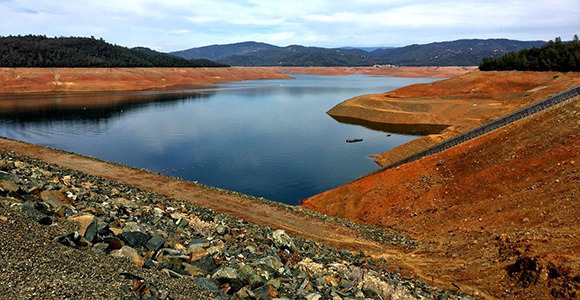
Lake Oroville (Photo Credit: Ray Bouknight/Flickr)
The news this week that the state of California Department of Water Resources will increase water allocation to 15 percent of what has been requested is an indication of two things: El Niño is having a positive impact on California’s water supplies, but we have a long way to go before we begin to heal the wounds the four-year drought has inflicted.
If El Niño continues to deliver rain and snow, there could be another modest increase in supplies. The National Weather Service said wet weather is expected to hit the Sacramento area late Thursday and continue through the weekend.
“Our modest increase underscores the fact that we still have a critical water shortage after four-plus years of drought that we don’t know when will end,” said Mark Cowin, director of the Department of Water Resources, in a statement published in the Sacramento Bee. “One look at our low reservoirs tells us that we need a lot more wet weather before summer.”
In the meantime, and beyond, California will have to continue to conserve.
The California Economic Summit, in its One Million Challenges, posed a water challenge: California needs to save one million more acre-feet of water each year. With Californians using substantially more water each year than the state’s infrastructure can reliably supply, the Summit will support the expansion of watershed management solutions that can help regions conserve, capture, and re-use enough water to achieve a sustainable water balance.
In a recent feature story in the San Gabriel Valley Tribune, a State Water Resources Control Board member said a more conservation-focused California is still learning to live in a time of drought.
But, 72-year-old Frances Spivy-Weber, Los Angeles County’s only representative on the Board, thinks conservation is taking.
She predicts traditional lawns will continue to disappear as younger Californians buy homes with less yard space because they don’t want to spend time mowing their lawns: “I think it is a huge change and I think it will shape the California look.”
Spivy-Weber spoke about another rising trend in water: decentralization. Soon, a neighborhood, a college dormitory or a large city building may have its own recycled water system or miniature desalination plant.
Even before the drought, Californians were using more water each year than the state’s infrastructure can sustainably supply. To create a reliable and environmentally sound water supply—for residents, businesses, and farms—California needs to conserve, capture, and re-use one million more acre-feet of water each year for a decade.
The California Economic Summit can contribute to this daunting challenge by helping state and regional leaders accelerate progress toward integrated water projects within watersheds that capture storm water and replenish groundwater, improve efficiency and reuse, and reduce flooding and water pollution.
For more information on the Summit, read the 2016 Roadmap to Shared Prosperity.
Meanwhile, as the winter moves along, scientists who follow our weather are reminding us that El Niño traditionally gives us wet weather late into winter. The two biggest El Niños on record, which developed over 1982-83 and 1997-98, brought double the rain and double the snowpack for California. This El Niño is in the same league as those two, but we’ll have to wait and see.
In the meantime, as the song says, let it rain (or more importantly) snow.

